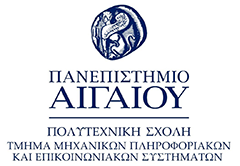Εκπαίδευση - Σπουδές
Ερευνητικά Ενδιαφέροντα
Διδασκαλία
Δημοσιεύσεις σε Διεθνή Περιοδικά (Journals)
Copyright Notice: This material is presented to ensure timely dissemination of scholarly and technical work. Copyright and all rights therein are retained by authors or by other copyright holders. All persons copying this information are expected to adhere to the terms and constraints invoked by each author's copyright. In most cases, these works may not be reposted or mass reproduced without the explicit permission of the copyright holder.
Επιστημονικά Συνέδρια (Conferences)
Copyright Notice: This material is presented to ensure timely dissemination of scholarly and technical work. Copyright and all rights therein are retained by authors or by other copyright holders. All persons copying this information are expected to adhere to the terms and constraints invoked by each author's copyright. In most cases, these works may not be reposted or mass reproduced without the explicit permission of the copyright holder.
Abstract
Blockchain Technologies, known as BCT have been praised by most people as a new and evolutionary means of ensuring secure and transparent data sharing and record keeping with potential uses in a number of sectors. The government sector is one of them. The potentials of DLTs are among the motivating reasons why most government agencies are looking to this technology to help make them become more efficient, accountable, cost-effective, and transparent. Some, on the other hand, are looking for ways in which the DLTs can help increase the trust in government agencies as well as various governmental institutions. Despite the endless potentials of the DLTs , they are still in infant stage and at the same time having a number of risks that may deter its future integration and use. This paper proposes a framework towards the integration of DLTs into government organizations of various levels like municipalities and public services that will help in introduction of them in governmental tasks such as digital ID management, secure document handling and voting while keeping them simple for administrators to use and apply in every organization and domain.
Abstract
Policy networks are highly important for the formulation and implementation of public policies, so it is quite valuable to exploit modern ICT in order to support them. This paper presents a novel method of supporting the large policy network of the European Union (EU), which consists of numerous actors geographically dispersed all over Europe, through advanced social media exploitation, in order to improve the quantity and quality of their interaction, and increase efficiency and effectiveness. Based on a series of workshops, in which a large number of individuals involved in EU policy network participated, initially its structure has been analyzed, and then the proposed method has been formulated. Furthermore, the architecture of the ICT infrastructure required for the application of this method has been designed. The main pillars of the proposed method (corresponding also to the main modules of its ICT infrastructure) are: profiling of important EU policy actors’ and reputation management, relevant documents’ storage and relevance rating, and finally advanced visualized presentation of them.
Abstract
The first generations of social media exploitation by government
were oriented towards the general public. Evaluations of them have shown that
they can provide some insights into the perceptions of the general public, however
in order to achieve the required higher levels of quality, depth and elaboration
it is necessary to target specific communities having strong interest and
good knowledge on the particular topic under discussion. The research presented
in this paper makes a contribution in this direction. It develops a novel
approach to social media exploitation by the European Union (EU), which aims
at leveraging its policy community, which consists of a big network of individuals/
policy stakeholders having various policy related roles and capacities,
geographically dispersed all over Europe. Its theoretical foundation is policy
networks theory. Based on a series of workshops, in which a large number of
such individuals participated, the structure of the EU policy community is initially
analysed, then the proposed approach is formulated and elaborated, and
finally the fuctional architecture of an ICT platform for supporting it is designed.
Theirb main pillars are: important policy stakeholders’ profiles and
reputation management, relevant documents’ repository and relevance rating,
and finally advanced visualized presentation of them.
Βιβλία
Copyright Notice: This material is presented to ensure timely dissemination of scholarly and technical work. Copyright and all rights therein are retained by authors or by other copyright holders. All persons copying this information are expected to adhere to the terms and constraints invoked by each author's copyright. In most cases, these works may not be reposted or mass reproduced without the explicit permission of the copyright holder.
Κεφάλαια σε Βιβλία
Copyright Notice: This material is presented to ensure timely dissemination of scholarly and technical work. Copyright and all rights therein are retained by authors or by other copyright holders. All persons copying this information are expected to adhere to the terms and constraints invoked by each author's copyright. In most cases, these works may not be reposted or mass reproduced without the explicit permission of the copyright holder.
Επιμέλεια Πρακτικών Διεθνών Συνεδρίων
Copyright Notice: This material is presented to ensure timely dissemination of scholarly and technical work. Copyright and all rights therein are retained by authors or by other copyright holders. All persons copying this information are expected to adhere to the terms and constraints invoked by each author's copyright. In most cases, these works may not be reposted or mass reproduced without the explicit permission of the copyright holder.




 Download
Download